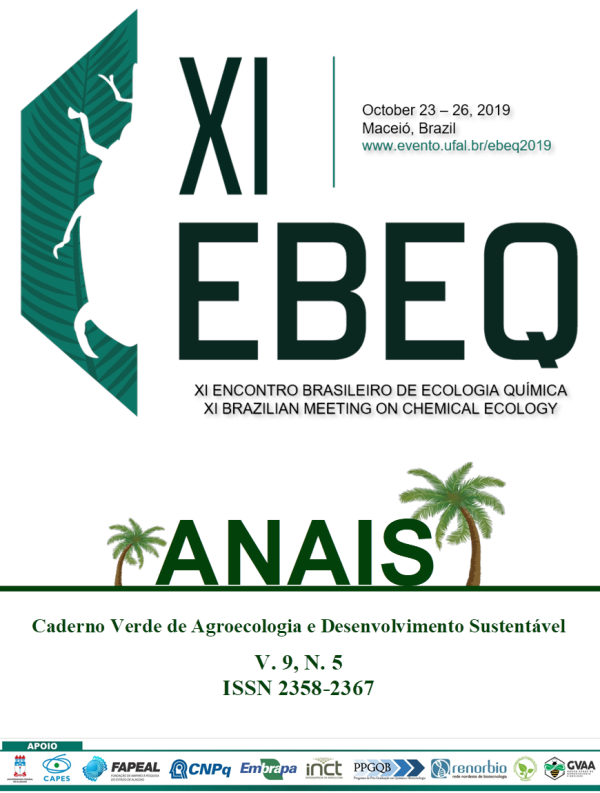EFFECT OF THE BAMBOO PYROLIGNEOUS EXTRACT ON Plutella xylostella L. (LEPIDOPTERA: PLUTELLIDAE)
Keywords:
REPELLENCE, PYROLYSIS, DIAMONDBACK MOTHAbstract
The search for alternative methods for vegetable pest control has increased in the last years. The pyroligneous extract (PE), obtained from smoke condensation during wood charring, is a promising alternative for the ecological management of pest insects. The brassicas have their production affected by different pests, such as Plutella xylostella. The objective of this work was to evaluate the effect of pyroligneous bamboo extract (Bambusa vulgaris) on P. xylostella. The bamboo culms were collected from mature clumps at the germplasm bank of the Center for Agricultural Sciences - AL and pyrolised in a Jung model LT6 2010 tubular oven to obtain the bio oil. As PE is not completely soluble, an emulsion was prepared according to Senhorini's (2010) methodology, by testing different concentrations of Tween and Span. The PE was subjected to separation through funnel filtration to remove tar. Toxicity tests were performed to find the upper and lower mortality limits for both emulsion and filtered extract to estimate lethal concentrations. The repellence index and ovicidal effect of the emulsions were also determined. Of the five emulsions tested only the emulsion with 5 g of Tween, 10 g of extract and 85 g of water was stable, but without uniform toxic activity for caterpillar control, not fitting the Probit estimate; in the same way for the filtered extract. For repellence, only the 20% filtered extract after 30, 60, 120 minutes and 24 hours of the larvae inoculation was repellent and the other concentrations were neutral. For the ovicidal effect, only the concentration of 20% presented the highest average of unviable eggs (50.85%), contrasting with 2.8% of the control. It is concluded that the pyroligneous extract emulsion and the filtered extract do not have uniform toxic activity for P. xylostella larvae control, but the filtered extract has repellent effect and ovicidal action.References
ADRIANSZ, T.D.; RUMMEY, J.M.; BENNETT, I.J. Solid phase extraction and subsequent identification by gás-chromatography-mass spectrometry of a germination cue present in smoke water. Analytical Letters, v. 33, n. 13, p. 2793-2804, 2000.
CASTELO BRANCO, M. et al. Uso de inseticidas para o controle da traça-do-tomateiro e traça-das-crucíferas: um estudo de caso. Horticultura Brasileira. Brasília, v.19, n. 1, p.60-63, 2001.
GUILLÉN, M. D.; IBARGOITIA, M. L. Relationships between the maximum temperature reached in the smoke generation processes from Vitis vinifera L. shoot sawdust and composition of the aqueous smoke flavouring preparations obtained. Journal of Agricultural and Food Chemistry, v. 44, n. 5, p. 1302–1307, 1996a.
GUILÉN, M. D.; IBARGOITIA, M. L. Volatile conponents of aqueous liquid smokes from Vitis vinifera L. shoots and Fagus sylvatica L. wood. Journal of the Science of Food and Agriculture, v. 72, n. 1, p. 104–110, 1996b.
GUILLÉN, M. D.; MANZANOS, M. J. Characterization of the components of a salty smoke flavouring preparation. Food Chemistry. v. 58, p. 97–102, 1997.
MAZZONETTO, F.; VENDRAMIM, J. D. . Efeito de substâncias de origem vegetal sobre Acanthoscelides obtectus (Say) (Col.: Bruchidae) em feijão armazenado. Neotropical Entomology, v. 32, n. 1, p.145-149, 2003.
POTTER, C. An improved laboratory apparatus for applying direct sprays and surface films, with data on the electrostatic charge on atomized spray films. Annals of Applied Biology, v. 39, p. 1-29. 1952.
SAS Institute Inc.Statistical Analysis System user's guide, version 9.1, Ed. Cary: Institute, USA, 2003.
TORRES, A.L. et al. Efeito de extratos aquosos de Azadirachta indica, Melia azedarach e Aspidosperma pryrifolium no desenvolvimento e oviposição de Plutella xylostella. Bragantia, v. 65, n. 3, p. 447-457, 2006.
Downloads
Published
How to Cite
Issue
Section
License
Termo de cessão de direitos autorias
Esta é uma revista de acesso livre, em que, utiliza o termo de cessão seguindo a lei nº 9.610/1998, que altera, atualiza e consolida a legislação sobre direitos autorais no Brasil.
O(s) autor(es) doravante designado(s) CEDENTE, por meio desta, publica a OBRA no Caderno Verde de Agroecologia e Desenvolvimento Sustentável, representada pelo Grupo Verde de Agroecologia e Abelhas (GVAA), estabelecida na Rua Vicente Alves da Silva, 101, Bairro Petrópolis, Cidade de Pombal, Paraíba, Brasil. Caixa Postal 54 CEP 58840-000 doravante designada CESSIONÁRIA, nas condições descritas a seguir:
O CEDENTE declara que é (são) autor(es) e titular(es) da propriedade dos direitos autorais da OBRA submetida.
O CEDENTE declara que a OBRA não infringe direitos autorais e/ou outros direitos de propriedade de terceiros, que a divulgação de imagens (caso as mesmas existam) foi autorizada e que assume integral responsabilidade moral e/ou patrimonial, pelo seu conteúdo, perante terceiros.
O CEDENTE mantêm os direitos autorais e concedem à revista o direito de divulgação da OBRA, com o trabalho simultaneamente licenciado sob a Licença Creative Commons do tipo atribuição CC-BY.
O CEDENTE têm autorização para distribuição não-exclusiva da versão do trabalho publicada nesta revista.
O CEDENTE têm permissão e são estimulados a publicar e distribuir seu trabalho online (ex.: em repositórios institucionais ou na sua página pessoal) a qualquer ponto antes ou durante o processo editorial, já que isso pode gerar alterações produtivas, bem como aumentar o impacto e a citação do trabalho publicado.








